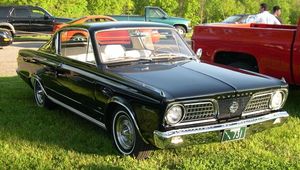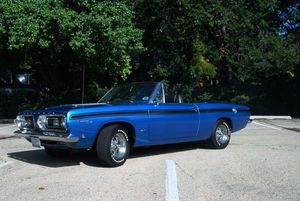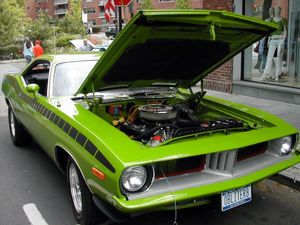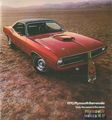.
Plymouth Barracuda
The Plymouth Barracuda, or 'Cuda, started out life as a humble A-body Valiant option package in 1964, and was Plymouth's (and Chrysler's) first stab at a "performance" car. The Barracuda actually beat the Ford Mustang to the market by 2 weeks when it was first introduced, so despite Ford's claims that the Mustang was the first "pony car" to the market, technically Chrysler could rightfully dispute that claim. But as we all know, the Mustang clearly trounced the Barracuda in sales right out of the gate and never looked back. That doesn't mean the Barracuda didn't find its rightful place in the ponycar market, it just took a little longer to find it. The Barracuda lasted 10 model years and spanned 3 generations, and until the E-body 1970 model, the Barracuda was one of the few Plymouth models throughout Chrysler history that was not also offered as a Dodge equivalent.
Here's a quick rundown on each generation:

| |
| Plymouth Barracuda | |
|---|---|
| Chrysler Corporation | |
| aka | 'Cuda |
| Production | 1964-1966 |
| Class | Compact |
| Body Style | 2-Door Fastback Coupe |
| Length | |
| Width | |
| Height | |
| Wheelbase | 108" |
| Weight | 3200-3500 lbs |
| Transmission | 3-Speed Manual, RWD 4-Speed Manual, RWD 3-Speed Automatic, RWD |
| Engine | 3.7L (225 cid) I6 4.7L (273 cid) V8 |
| Power | 90-235 hp |
| Similar | N/A |
| Designer | Dick McAdam |
| Platform | A |
1st Generation (1964-1966)
1964
The 1st gen Barracuda at first was simply an option package for the successful but humble Valiant. It was a 2-door coupe with a huge fastback rear window design, and most (if not all) had a unique (for the time) fold-down rear seat, enhancing cargo space. Engine choices mirrored the Valiant's, standard was the 2.8L (170 cid) Slant 6, and the only V8 was the 4.7L (273 cid). Both engines could have a 3-speed or 4-speed manual, or a 3-speed automatic transmission. Since the car was technically a "Valiant Barracuda", Valiant badging was used on the car.
1965
This year, no doubt inspired by the success of the Ford Mustang, Plymouth decided to give the Barracuda a bit more kick with a new sport-oriented Formula S model. This consisted of a 235 hp version of the 273 engine, called the "Commando". This engine, like the others, could have a 3-speed or 4-speed manual, or a 3-speed automatic. This package had special stiffer springs, front anti-roll bar, special "Formula S" badging. Base models continued as before.
1966
1966 Barracudas had an all new eggcrate grille and the parking lights were relocated to the bumper, but were little else changed. Base and Formula S models continued, as did their respective drivetrain choices. This would be the final year for the "Valiant Barracuda" generation. Even though 1st gen Barracudas were certainly unique (its best and worst quality), they were no match for its arch-rival Ford Mustang in terms of sales, outselling the Barracuda by no less than 8 to 1 (ouch!). An all new 2nd gen model would debut the next year.

| |
| Plymouth Barracuda | |
|---|---|
| Chrysler Corporation | |
| aka | 'Cuda |
| Production | 1967-1969 |
| Class | Compact |
| Body Style | 2-Door Fastback Coupe 2-Door Notchback Coupe 2-Door Convertible |
| Length | |
| Width | |
| Height | |
| Wheelbase | 108" |
| Weight | 3200-3600 lbs |
| Transmission | 3-Speed Manual, RWD 4-Speed Manual, RWD 3-Speed Automatic, RWD |
| Engine | 3.7L (225 cid) I6 (1967-1969) 4.7L (273 cid) V8 (1967) 5.2L (318 cid) V8 (1968-1969) 5.5L (340 cid) V8 (1968-1969) 6.3L (383 cid) V8 (1967-1969) 7.2L (440 cid) V8 (1969) |
| Power | 90-375 hp |
| Similar | N/A |
| Platform | A |
2nd Generation (1967-1969)
1967
The "pony car" market really started heating up this year - Ford restyled the Mustang and introduced a Mercury version called the Cougar, GM introduced its all-new pony car F-body twins, the Chevrolet Camaro and Pontiac Firebird, but Plymouth was determined to be a relevant player with the all-new 1967 Barracuda. Although it was still based on the A-body Valiant, it had an all-new, less awkward-looking body than the previous generation and shared no body panels with the Valiant - it even got its own emblems and wasn't any longer the "Valiant Barracuda". This year, there were 3 bodystyles available - the fastback body was still available but this time it didn't have the huge rear window - it was now more of a smaller, flat conventional design, a la the Mustang fastback's. There was now also a notchback coupe and a convertible version. One major way the Barracuda differed from the other pony car competition was the it didn't use the now-trademark "long hood, short deck" styling theme, which may or may not have been a wise decision, depending on one's point of view.
In any case, the Slant-6 and 273 V8s carried over from the previous generation, as did their transmission choices, but to better compete with Ford Mustang GT's 390 and Pontiac Firebird's 400 big-inch V8s, Chrysler's big-block 6.3L (383 cid) V8 was now an option in the Formula S. Unfortunately since the A-body engine bay wasn't designed to hold a big-block, power steering or air conditioning couldn't be ordered with the 383 - they simply didn't fit, plus the 383 made the car very nose-heavy. At first, a 280 horse version was offered, but a 325 horse option became available in mid-year. Both versions were available on all bodystyles.
1968
The biggest visual change was the addition of the newly-mandated side-marker lights, which were small and round this year. The Slant-6 was standard, but the 273 was dropped and replaced by the 230 hp 5.2L (318 cid) V8. Another worthy (and very welcome) V8 option was the all-new 275 hp 5.5L (340 cid) V8, which was basically a bored-out 318. Even AMC got into the pony car act this year with its all-new Javelin. The big-block 383 was still the top-dog option on the Formulas, but the small-block 340 was considered by many critics a much wiser choice than the 383, as the 340 could have power steering and air conditioning, plus it handled alot better since it wasn't nearly as nose-heavy, making it a much more pleasant car to live with on a daily basis. The 383 models, many said, were best left to straight-line dragstrip-duty only.
1969
Side-marker lights were now larger and rectangular vs small and round like last year's, which was the biggest visual change. Hardtop, fastback and convertibles continued as before. Engine choices were still the Slant 6, 318, 340 and 383 V8s, all available with a 3-speed or 4-speed manual, or 3-speed automatic. This year, a "'Cuda" sport option package replaced the Formula S model. Now the car could be officially known as 'Cuda, even though many fans had already been calling it that for years. A limited-run (the unofficial number is around 500) for 'Cuda fastback models only was the availability of the 375 hp 7.2L (440 cid) V8. The 383 already had its driveability issues and the 440 only amplified them, as it naturally couldn't have power steering or air conditioning either. So, naturally, the 440 Cuda appealed strictly to the go-fast, straight-line dragstrip addicts, as such a beast was almost undriveable on most public roads.
The 2nd gen 'Cuda, while a formidable pony car player, was still not nearly as successful as the Ford or GM pony car entries with buyers, and considering it didn't sport the required "long-hood, short deck" styling, many, perhaps unfairly, dismissed the Barracuda as an also-ran. That situation, however, would change with the following 3rd generation models.
Even though the Barracuda name would live on as a totally different animal, the all-new 1970 Valiant-based Duster, would effectively be a spiritual replacement for the A-body Barracuda.

| |
| Plymouth Barracuda | |
|---|---|
| Chrysler Corporation | |
| aka | 'Cuda |
| Production | 1970-1974 |
| Class | Compact |
| Body Style | 2-Door Coupe 2-Door Convertible |
| Length | 190" |
| Width | 76.5" |
| Height | 51.5" |
| Wheelbase | 108" |
| Weight | 3400-3800 lbs |
| Transmission | 3-Speed Manual, RWD 4-Speed Manual, RWD 3-Speed Automatic, RWD |
| Engine | 3.7L (225 cid) I6 (1970-1972) 5.2L (318 cid) V8 (1970-1974) 5.5L (340 cid) V8 (1970-1973) 5.5L (340 cid) 3x2 V8 (1970) 6.3L (383 cid) V8 (1970-1971) 7.0L (426 cid) Hemi V8 (1970-1971) 7.2L (440 cid) V8 (1970-1971) 7.2L (440 cid) 3x2 V8 (1970-1971) |
| Power | 90-425 hp |
| Similar | Dodge Challenger |
| Platform | E |
| Designer | John Herlitz |
3rd Generation
1970
There was an all new Barracuda for 1970, now based on the all-new E-body platform, which was a shortened B-body Road Runner platform. No longer would the Barracuda be based on the humble A-body Valiant chassis, this bodystyle would sever all ties with its platform-sharing predecessor. Fastback models were dropped, there was now only a notchback hardtop coupe and a convertible. And this time around, Dodge would have a twin called the Challenger, although they would share no body panels and the Dodge would have a 2 inch longer wheelbase. The new bodystyle was evidence that Chrysler was finally serious about getting serious in the pony car market, especially after watching GM and Ford for years rack up 200,000+ yearly sales for their entries... but one had to wonder if this was a classic case of "too little, too late", especially since this same year, GM had redesigned its F-body twins, the Camaro and Firebird, to an all-new European-inspired fastback design. This, plus insurance companies had really started cracking down on muscle cars in general, and would all soon be emasculated by all-new emission laws.
If Plymouth indeed introduced the E-body Barracuda to the muscle-car party too late, it certainly made up for it by not arriving unnoticed. The 70 Barracuda was available with just about every engine in Chrysler's lineup in some variation, starting with the 3.7L 225 cid Slant-6 for the base models all the way to the holy-grail 426 Hemi on the 'Cudas. 318s could be had on base coupes, but the 'Cuda models would return with the 383 V8 standard (although the 340 could be had as a credit option). Options were the 440 (4 bbl and 6 bbl) and the aforementioned Hemi. Since the E-body was a shortened B-body frame, it accomodated a big-block V8 much better than the previous generation, and they could all have power steering and air conditioning (except the Hemi or the 440+6, which weren't available with A/C). Plus they could have shaker hoods, ram-air hoods, just about any color you can think of (including pink and purple)... the array of choices and combinations were nothing short of dizzying - the option list alone had to be about the size of a small-town telephone directory.
For those that desired a little bit of luxury, a Gran Coupe package was available, similar to the Dodge Challenger SE, which included a vinyl roof, nicer interior and extra chrome on the outside. A very limited-edition AAR (All American Racers) package was also available (similar to the Dodge Challenger T/A), which included (among other things) the 340 V8 with the 3x2 "Six Pack" carburetor setup (exclusive to the AAR), fiberglass hood (in flat-black paint), strobe-striping on the sides with a unique AAR badge, and chrome side exhaust tips. The AAR could be had with a 4-speed manual or the 727 3-speed automatic.
1971
The biggest visual change was a quad headlight setup, the first (and only) time in the Barracuda's tenure. Front fenders gained 4 diagonal side gills. Taillights were revised too, but drivetrain and bodystyle choices remained the same as in 1970 and once again could be had with just about any variation or combination you could imagine, with the exception of the previous 'Cuda AAR (along with its 340+6 engine), which was dropped after last year. The 340-4, however, was now officially the 'Cuda's standard engine.
A 1971 Top Banana on white 'Cuda convertible was prominently featured on the hit TV show Nash Bridges with ran from 1996-2001 and starred Don Johnson and Cheech Marin.
1972
'Cuda fans (and muscle/pony car fans in general) were in for a shock this year, as the party was over as far as big block V8s, shaker hoods and wild paint schemes with high-impact colors were concerned - they were now gone, never to return. Convertibles were gone too, the hardtop was the only body style left. The top engine option was now the 340 V8, and even that engine was hit by a horsepower drop from 275 to 240. The Slant-6 and 318 V8 remained and took small horsepower hits as well. 'Cudas were still available, as were the base coupes, and visual changes included reverting back to dual headlights and getting round tail lights and reverse lights in the rear, similar to the contemporary Chevrolet Camaro. The luxury Gran Coupe model, however, was discontinued. The 318 was now standard in the 'Cuda with the 340 optional.
1973
The Slant-6 was dropped this year (which was rarely ordered anyway), the base engine was now the 318 V8 in both the base and the 'Cuda, but the 'Cuda could still have the 340 V8 as an option. Visual changes included larger, more pronounced side marker lights, and large black rubber "bumperettes" to satisfy new 5-MPH bumper standards.
1974
The Barracuda's last hurrah, it had sure been an interesting ride. The only major change was that the 340 was no longer available, to be replaced by the 5.9L (360 cid) V8, available only on the 'Cuda models. The 318 was still standard on both. By this time, the Ford Mustang was now downsized to the Pinto chassis (talk about how the mighty had fallen!), the Mercury Cougar was now a personal-luxury twin to the mid-size Ford Torino... the writing was clearly on the wall. AMC would kill off its lone pony car entry, the Javelin after this year, and after a measly 15,000 units sold this year, Chrysler mercifully threw in the towel on the Barracuda and Challenger as well. Only GM would keep the faith with its Camaro and Firebird... but even they would ultimately "lose the faith" 3 decades later.

